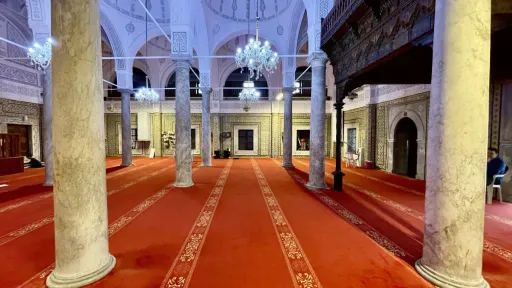Historic Georgian Mosque stands out for ornate Ottoman design

Located in the Old City near the Ancient Port, the mosque was built in the early 19th century and stands out among Ottoman-era mosques in North Africa for its tile work.
The mosque was commissioned by Georgian Mustafa Bey, a merchant who settled in Tripoli under the service of Karamanlı Yusuf Pasha, the governor of the Tripolitania province during the Ottoman period. It was completed in the first quarter of the 19th century in the heart of the Old City.
Abdulmuttalib Abu Salim, a cultural historian and former official at Libya’s Ministry of Culture, told Anadolu Agency (AA) that the mosque is a rare architectural gem in North Africa.
“This beautiful mosque is a masterpiece of architecture,” Abu Salim said. “The abundance of ornamental detail, delicate craftsmanship, and aesthetic intricacy make it one of the rare structures in the region.”
The Georgian Mosque is located in the Bab el-Bahr (Sea Gate) area of the Old City, right next to the Marcus Aurelius Arch, a symbolic relic from Tripoli’s Roman era, Abu Salim noted.
He explained that Mustafa Bey, who commissioned the mosque, was a Georgian-born merchant who settled in Tripoli during the rule of Karamanlı Yusuf Pasha. He later served in the city’s port administration.
“Mustafa Bey was the son-in-law of Yusuf Pasha, having married his eldest daughter in the early 19th century,” Abu Salim said. “He advanced in the navy to a position equivalent to today’s Ministry of Maritime Affairs.”
Abu Salim added that Mustafa Bey fell in love with Tripoli and chose to settle there permanently, earning the nickname “Georgian” for his origins.
“The mosque was built over 15 years, from 1820 to 1834,” he said. “It measures 16 meters by 16 meters in a square layout, with an upper floor shaped like a ‘U.’”
The mosque contains nine marble columns inside and a total of 25 supporting columns, some of which may have been imported from other cities, Abu Salim said.
He noted that the mosque’s design also reflects Andalusian and Italian architectural traditions and that both the interior and exterior are richly decorated with tiles.
“The tops of the columns and sections of the tile work feature finely crafted plaster ornamentation,” he said. “The mosque has 16 domes. Directly opposite the mihrab is a section reserved for important guests, which we call the ‘Südde.’ Its extensive tile decoration makes it unique.”
Abu Salim added that the mosque’s wooden pulpit was removed in 2014 for preservation and is planned to be displayed in the new Libya National Museum.
He said Mustafa Bey and his family are buried in a tomb adjacent to the mosque.
AA


